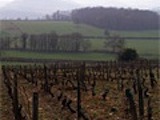Cédric Cuccia PhD thesis
 Climate change impact on Pinot noir phénology over Burgundy
Climate change impact on Pinot noir phénology over Burgundy
Defended on the 14th May 2013
Funding: bureau interprofessionnel des vins de Bourgogne et région Bourgogne
Supervisors: Yves Richard (dir. Thèse, CRC), Thierry Castel (co-dir., CRC) and Benjamin Bois (co-dir., CRC)
Started in October 2008
Abstract
The viticulture is an important economic and cultural sector in Burgundy. The current climate change raises a number of issues including its impact on crops. In this thesis, the idea is to develop a methodology to address the problem: what are the potential impacts of changes in temperature on the phenology of Pinot noir in Burgundy for years 2031-2048?
The evolution of temperatures in Burgundy since 1961 is characterized by a positive temperature shift at the end of the 1980s followed by a period where the temperature increases of about 1.5 °C.
One of the interests of this thesis is to develop, following a strategy developed during the thesis, a spatial database conducted over the period 1989-2009 to estimate the ability of the WRF model to reproduce the climate Burgundy by disaggregating large scale data. The model reproduces satisfactorily the seasonal and spatial variability in global climate despite bias (cold on the Tx and hot on the Tn).
To regionalize the climate change, WRF was used to disaggregate data from the scenario SRES/A2 on the periods 1970-1987 and 2031-2048. After being evaluated and inter-compared three phenological models, using average temperatures data to simulate the dates of occurrence of phenological stages of Pinot Noir, have been applied to these decompositions.
The impact of warming temperatures on the horizon 2031-2048 (SRES/A2), estimated at 1.35 ° C on average, is characterized by an earlier flowering and veraison of about 7 and 15 days respectively. The interstadial duration is also reduced of about 5 days.
Keywords
climate change, temperature, pinot noir, Burgundy, phenology, regional climate model
Jury
Hervé Quenol, université de Rennes 2 – rapporteur
Cornelis Van Leeuwen, Bordeaux sciences agro – rapporteur
Iñaki Garcia de Cortazar-Atauri, INRA Avignon – examinateur
Daniel Joly, université de Franche-Comté – examinateur
Malika Madelin, Université Paris 7 – examinatrice
Christine Monamy, BIVB – invitée
Denis Thévenin, Météo-France – invité
Yves Richard, université de Bourgogne – directeur de thèse
Benjamin Bois, université de Bourgogne – co directeur
Thierry Castel, AgroSup Dijon – co directeur
- extrait:
- lien_externe:
- kc_data:
- a:8:{i:0;s:0:"";s:4:"mode";s:0:"";s:3:"css";s:0:"";s:9:"max_width";s:0:"";s:7:"classes";s:0:"";s:9:"thumbnail";s:0:"";s:9:"collapsed";s:0:"";s:9:"optimized";s:0:"";}
- kc_raw_content:
 Climate change impact on Pinot noir phénology over Burgundy
Climate change impact on Pinot noir phénology over BurgundyDefended on the 14th May 2013
Funding: bureau interprofessionnel des vins de Bourgogne et région Bourgogne
Supervisors: Yves Richard (dir. Thèse, CRC), Thierry Castel (co-dir., CRC) and Benjamin Bois (co-dir., CRC)
Started in October 2008
Abstract
The viticulture is an important economic and cultural sector in Burgundy. The current climate change raises a number of issues including its impact on crops. In this thesis, the idea is to develop a methodology to address the problem: what are the potential impacts of changes in temperature on the phenology of Pinot noir in Burgundy for years 2031-2048?
The evolution of temperatures in Burgundy since 1961 is characterized by a positive temperature shift at the end of the 1980s followed by a period where the temperature increases of about 1.5 °C.
One of the interests of this thesis is to develop, following a strategy developed during the thesis, a spatial database conducted over the period 1989-2009 to estimate the ability of the WRF model to reproduce the climate Burgundy by disaggregating large scale data. The model reproduces satisfactorily the seasonal and spatial variability in global climate despite bias (cold on the Tx and hot on the Tn).
To regionalize the climate change, WRF was used to disaggregate data from the scenario SRES/A2 on the periods 1970-1987 and 2031-2048. After being evaluated and inter-compared three phenological models, using average temperatures data to simulate the dates of occurrence of phenological stages of Pinot Noir, have been applied to these decompositions.
The impact of warming temperatures on the horizon 2031-2048 (SRES/A2), estimated at 1.35 ° C on average, is characterized by an earlier flowering and veraison of about 7 and 15 days respectively. The interstadial duration is also reduced of about 5 days.
Keywords
climate change, temperature, pinot noir, Burgundy, phenology, regional climate model
Jury
Hervé Quenol, université de Rennes 2 – rapporteur
Cornelis Van Leeuwen, Bordeaux sciences agro – rapporteur
Iñaki Garcia de Cortazar-Atauri, INRA Avignon – examinateur
Daniel Joly, université de Franche-Comté – examinateur
Malika Madelin, Université Paris 7 – examinatrice
Christine Monamy, BIVB – invitée
Denis Thévenin, Météo-France – invité
Yves Richard, université de Bourgogne – directeur de thèse
Benjamin Bois, université de Bourgogne – co directeur
Thierry Castel, AgroSup Dijon – co directeur
